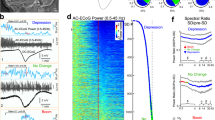Abstract
Spreading depression can arise spontaneously in convulsions, migraine attacks, vascular lesions, and other pathological brain states. However, the methodological complexity of recording a direct current potential in the neocortex in humans and conscious animals significantly limits studies of the functional consequences of spreading depression. The present report describes a detailed analysis of the EEG dynamics at the moment of development of spreading depression waves and identifies specific signs allowing spreading depression to be recorded without recording changes in the direct current potential. At the moment of arrival of spreading depression, the interhemisphere equilibrium is highly disturbed because of large decreases in high-frequency activity. The time parameters of the dynamics of the gamma-1 and gamma-2 ranges were the most informative features of the development of spreading depression waves. Increases in power in the delta range developed with some delay on the background of a deep inhibition of high-frequency activity and are in essence a consequence of spreading depression. The encephalographic criteria of spreading depression waves identified here can significantly simplify the detection of this phenomenon both in experimental and clinical conditions in a number of pathological brain states.
Similar content being viewed by others
References
V. I. Koroleva, N. A. Gorelova, and L. V. Vinogradova, Leao Depression in Brain Structures [in Russian], Nauka, Moscow (1993).
V. I. Koroleva, V. I. Davydov, G. Ya. Roshchina, and A. V. Sulimov, “Long-lasting unilateral changes in electrocorticograms in conscious rabbits after single waves of propagating depression,” Zh. Vyssh. Nerv. Deyat., 53, No. 4, 437–445 (2003).
J. Bures, O. Buresova, and J. Krivanek, The Mechanism and Application of Leao’s Spreading Depression of Electroencephalographic Activity, Academic Press, New York (1974).
“Ethical principles and guidelines for experiments on animals, Swiss Academy of Medical Sciences,” Experientia, 51, 1–3 (1995).
P. J. Goadsby, “Migraine, aura and cortical spreading depression: why are we still talking about it?” Ann. Neurol., 49, 4–6 (2001).
A. Gorji, “Spreading depression: a review of the clinical relevance,” Brain Res. Rev., 38, 33–60 (2001).
D. C. Haas and G. S. Ross, “Transient global amnesia triggered by mild head trauma,” Brain, 109, 251–257 (1986).
K. A. Hossman, “Periinfarct depolarization,” Brain Metab. Rev., 8, 195–208 (1996).
M. E. Kelly, R. A. Battye, and D. C. McIntyre, “Cortical spreading depression reversibly disrupts convulsive motor seizure expression in amygdala-kindled rats,” Neurosci., 91, 305–313 (1999).
V. I. Koroleva, L. V. Vinogradova, and J. Bures, “Reduced incidence of cortical spreading depression in the course of pentylenetetrazol kindling in rat,” Brain Res., 608, 107–114 (1993).
V. I. Koroleva and J. Bures, “The use of spreading depression waves for acute and long-term monitoring of penumbra zone of focal ischemic damage in rats,” Proc. Natl. Acad. Sci. USA, 93, 3710–3714 (1996).
A. A. P. Leao, “Spreading depression of activity in the cerebral cortex,” J. Neurophysiol., 7, 359–390 (1944).
A. A. P. Leao, “Further observation of the spreading depression of activity in the cerebral cortex,” J. Neurophysiol., 10, 409–414 (1947).
H. Martins-Ferreira, M. Nedergaard, and C. Nicholson, “Perspectives on spreading depression,” Brain Res. Rev., 32, 215–234 (2000).
M. Nedergaard and A. J. Hansen, “Characterization of cortical depolarization evoked in focal cerebral ischemia,” J. Cereb. Blood Flow Metab., 13, 568–574 (1993).
S. Ochs, K. Hunt, and H. Booker, “Spreading depression using chronically implanted electrodes,” Amer. J. Physiol., 200, 1211–1214 (1961).
J. Olesen, B. Larsen, and M. Lauritzen, “Focal hyperemia followed by spreading oligemia and impaired activation of rCBF in classic migraine,” Ann. Neurol., 9, 344–352 (1981).
A. A. Parsons, “Recent advances in mechanisms of spreading depression,” Curr. Opin. Neurol., 11, 227–231 (1998).
G. G. Somjen, P. G. Aitken, G. L. Czeh, O. Herreras, J. Jing, and J. N. Young, “Mechanisms of spreading depression: a review of recent findings and a hypothesis,” Can. J. Physiol. Pharmacol., 70,Supplement, S248–254 (1992).
H. C. Tuckwell and R. M. Miura, “A mathematical model for spreading depression,” Biophys. J., 23, 257–276 (1978).
Author information
Authors and Affiliations
Additional information
__________
Translated from Zhurnal Vysshei Nervnoi Deyatel’nosti imeni I. P. Pavlova, Vol. 55, No. 4, pp. 437–443, July–August, 2005.
Rights and permissions
About this article
Cite this article
Koroleva, V.I., Davydov, V.I. & Roshchina, G.Y. Suppression of EEG gamma activity — an informative measure of spreading depression waves in the neocortex of the conscious rabbit. Neurosci Behav Physiol 36, 625–630 (2006). https://doi.org/10.1007/s11055-006-0067-z
Received:
Accepted:
Issue Date:
DOI: https://doi.org/10.1007/s11055-006-0067-z




